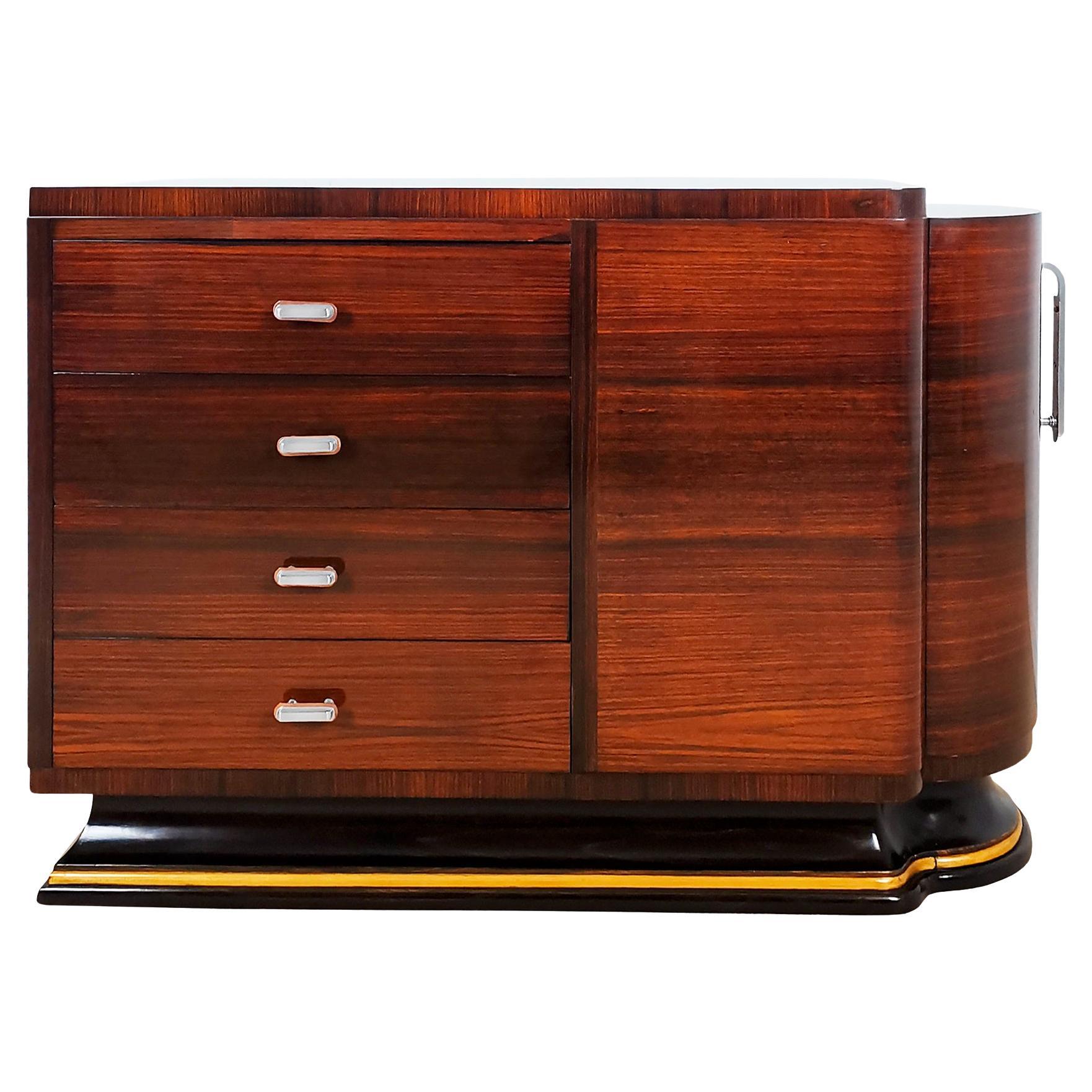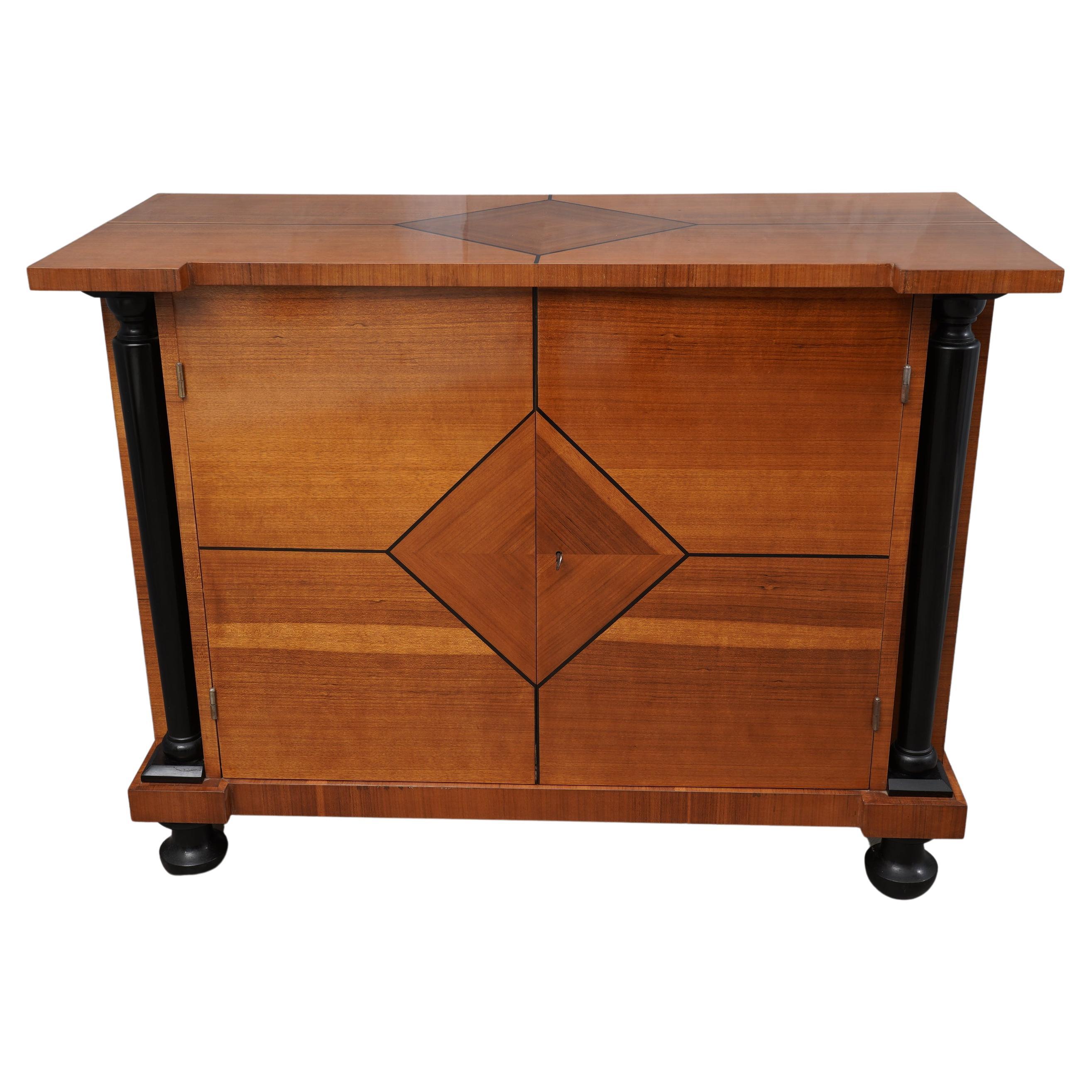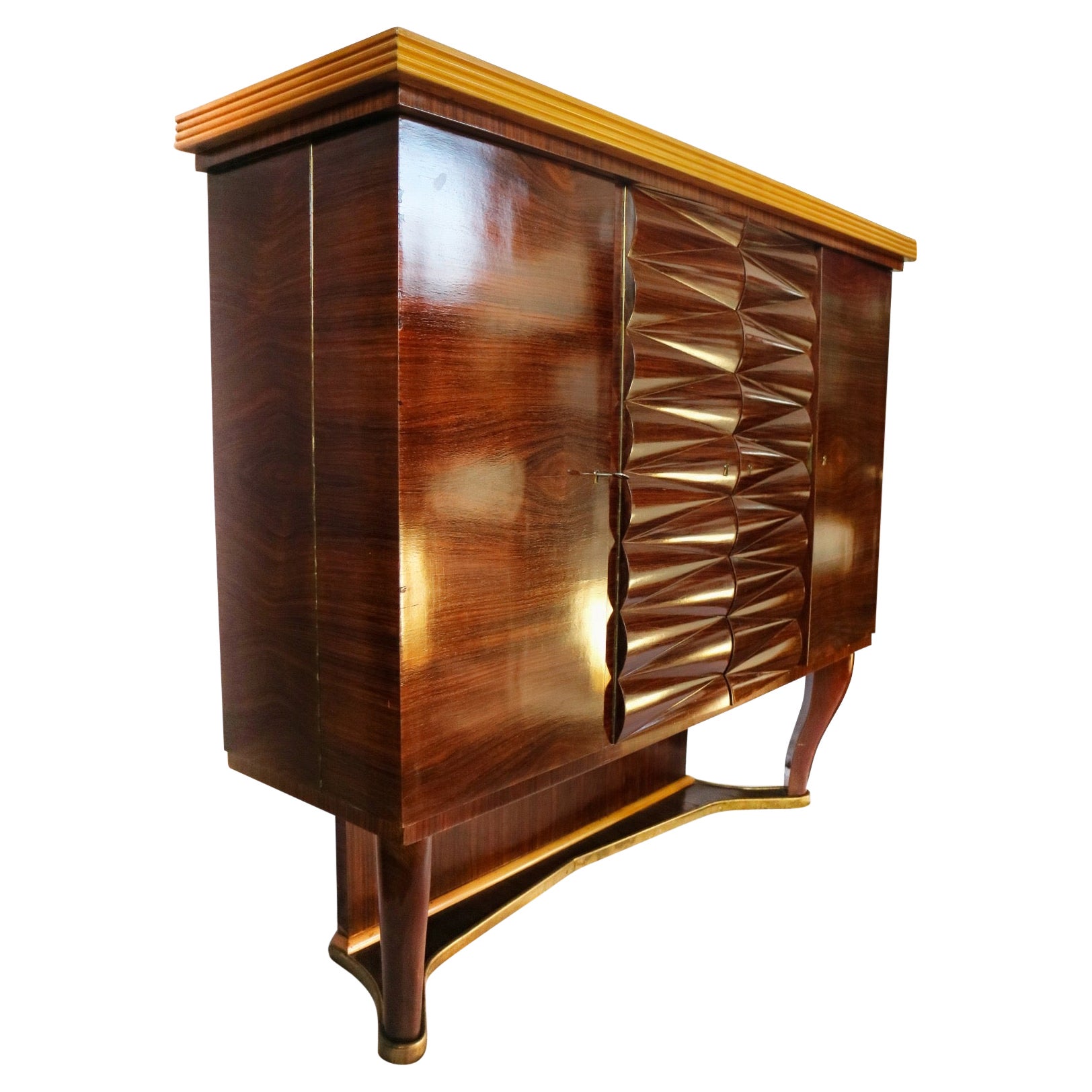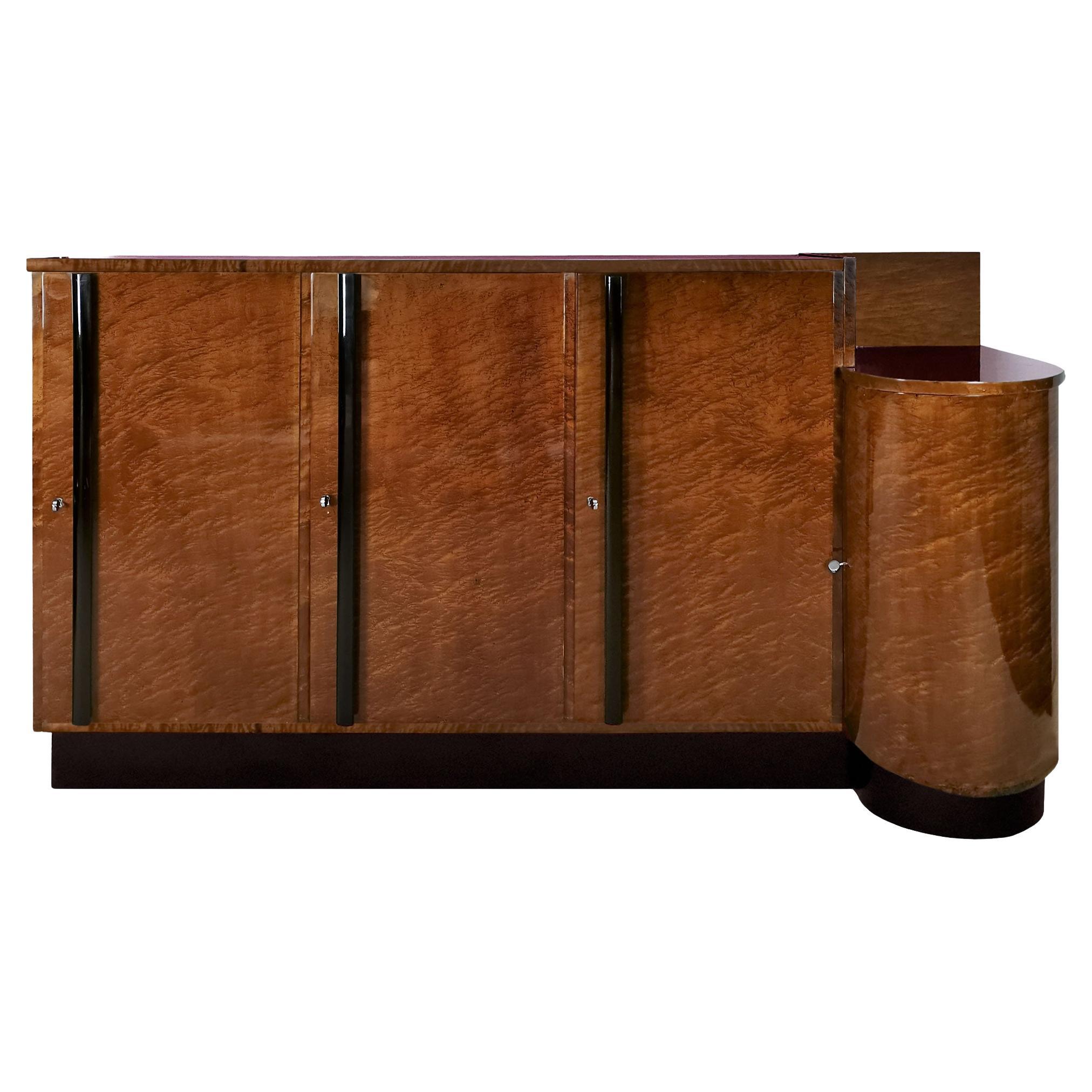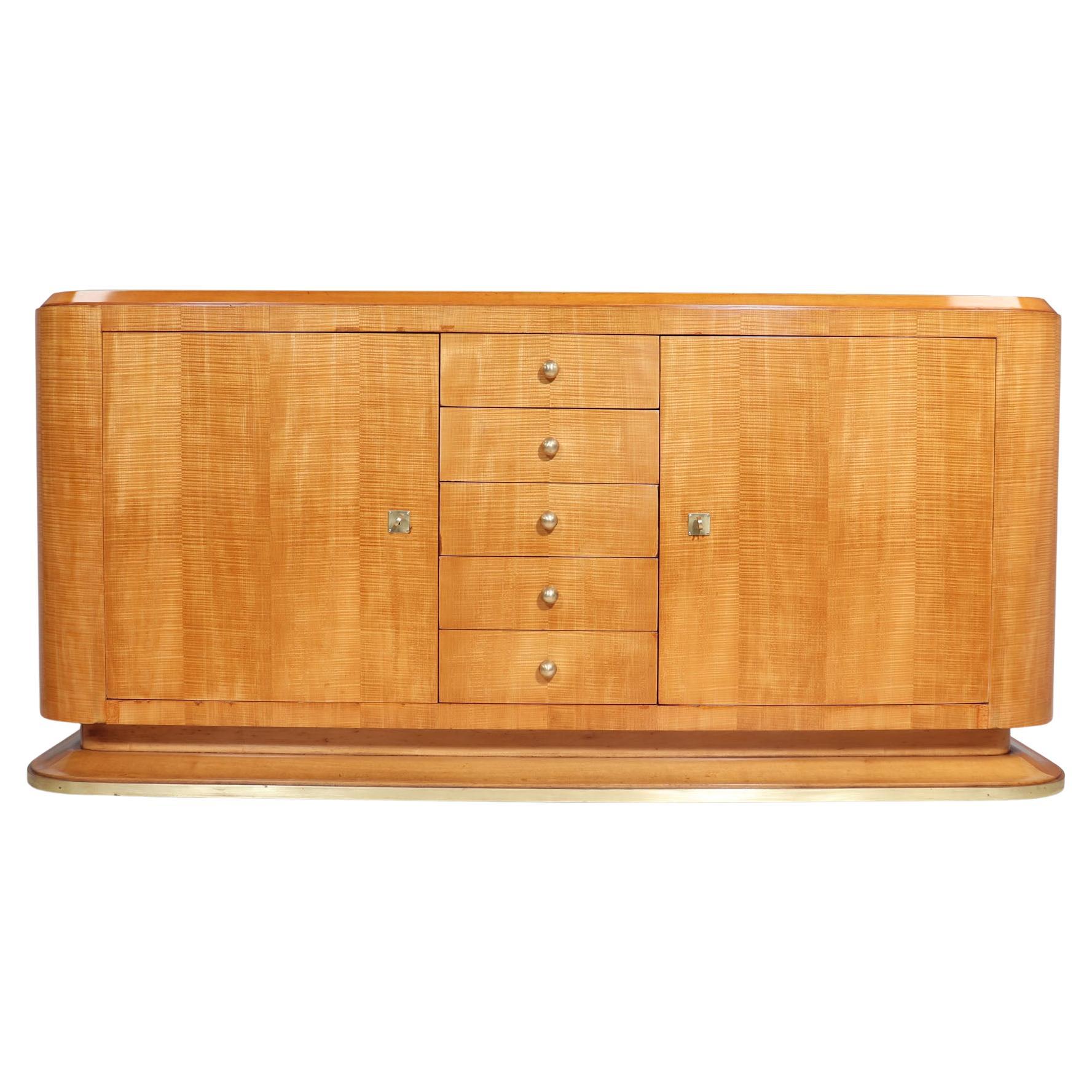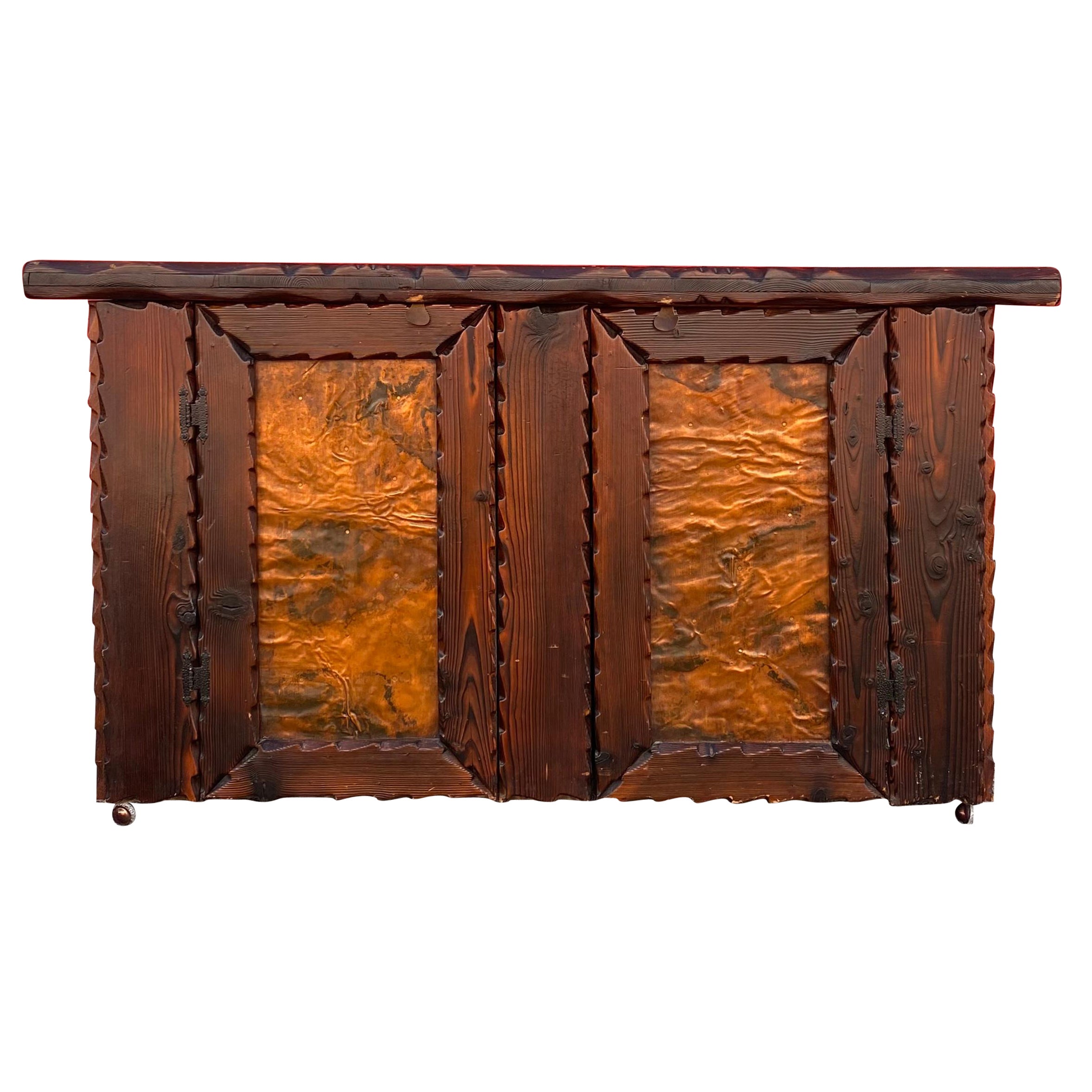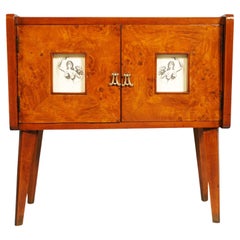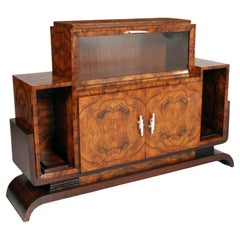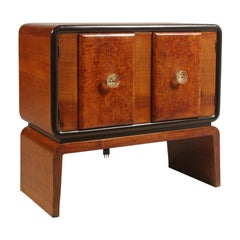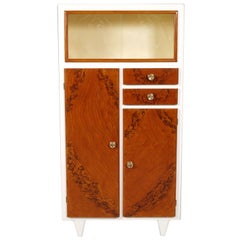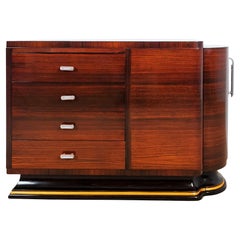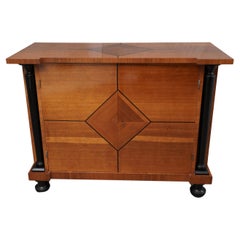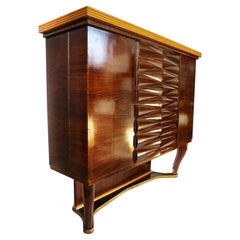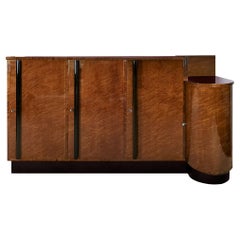Items Similar to 1940s Art Decò Rounded Cabinet Dry Bar Sideboard by A. Fallica for A. Liporesi
Want more images or videos?
Request additional images or videos from the seller
1 of 10
1940s Art Decò Rounded Cabinet Dry Bar Sideboard by A. Fallica for A. Liporesi
$9,296.99
£6,884.11
€7,800
CA$12,784.75
A$14,217.88
CHF 7,442.41
MX$173,440.90
NOK 93,516.55
SEK 87,964.38
DKK 59,386.37
About the Item
Art Decò Rounded cabinet dry bar sideboard front and side doors by Alfio Fallica for Alfonso Liporesi, in white oak with illuminated upper compartment. Generous sideboard with front and side spaces, very useful for bar and lunch services. Murano glass handles. Aluminum edging.
LIPORESI, Alfonso : 1919-2001
Alfonso Liporesi was an artist, a designer and a furniture manufacturer with "Liporesi Arredamenti d'Arte, Bologna", famous above all for having created the "VENCHI" chain of shops in many Italian cities and furnishings for France, Belgium and Germany.
As an artist, Alfonso Liporesi's work has been offered at auction multiple times, with realized prices ranging from 1,679 USD to 2,713 USD, depending on the size and medium of the artwork. Since 2019 the record price for this artist at auction is 2,713 USD for Tabouret moderniste en chêne, assise circulaire concave reposant sur une base légèrement bombée entourée d'un cerclage en aluminium brossé., sold at Tajan in 2022.
As designers he is famous for his Bar Cabinet with mirrored glass inserts and marble top,1950s; also sofas, coffee tables, poofs, sold at auction for thousands of euros.
FALLICA, Alfio
He was born in Paternò (Catania) on 18 April. 1898 by Salvatore, farmer, and Maria Russo. He attended the high school of architecture in Rome and already before graduating (1931) he participated in numerous exhibitions.
In May 1925 he exhibited at the headquarters of the Roman engravers and artists group, together with Eugenio Fegarotti from Catania.
On that occasion, Fallica stood out above all for his originality and his skills as a designer: "he knows how to draw well and also excellently summarize with a personal and architectural character, avoiding the useless and abolishing conventionalism" (Scarpa, 1925, p 5). In addition to the drawings, in the same exhibition he also presented some etchings.
In 1925 he participated in the III Rome Biennial (see Il Messaggero, 1 July 1925) and in 1927 in the III International Exhibition of Monza and the II Werkbund Exhibition in Stuttgart. Furthermore, in 1927 he won first prize in the competition for the monument to the financial police in Rome. Also in Rome, in 1928 he participated in the 1st Italian Exhibition of Rational Architecture.
Among the 42 exhibiting architects only two came from southern and insular Italy: Fallica and G. Marletta from Catania (Cennamo, 1973, p. 101). Fallica presented seven projects, some of which were already under construction: the Cutore villa on Etna, the "citrus laboratory" in Paternò, the Fegarotti villa in Fregene, the Fegarotti villa in Rome, the entrance to the Plaja in Catania ( the drawing, which evokes De Chirico atmospheres, is found in Catania, with F. Mariela's daughter), the transformation of the small house owned by Cutore and David on Etna, the arrangement of the pavilion of the Chamber of Commerce in Milan, a perspective and a elevation of his study.
In the project for Villa Cutore on Etna, among the simplicity of the straight lines and flat surfaces, an excessive rigor emerges, a little chastened and "not sufficiently animated by the shadowy voids of the large openings, the external stairs, the very thin railings" ( Rocca, 1988, p. 101). In Paternò's "citrus laboratory", however, the linear forms interact with the curvilinear volumes. A more complex operation was the Fegarotti villa in Viale Bruno Buozzi in Rome, defined as a "Mediterranean interpretation of rationalist principles" (De Guttry-Maino, 1988, p. 148), in which the only historicist insertions are evident in the gables." sixteenth century" and in the pillar-tower which refers to art nouveau.
In 1929 F. designed and built the Fecarotta jewelery shop in via Etnea n. in Catania. 172 (today only the sign and a large round table, designed by him, remain). Around 1930, still in Catania, he designed Villa Caponetto, built in via Passo di Aci.
It is an eclectic architecture in which Phallica's interest in the deco taste appears evident, but also in the Palermo tradition (Arab-Norman) in the red domes and in classical culture, in the use of the cornucopia which frequently appears as the theme song for Fallica's works. Finally, it is worth noting the turret in which the original insertion of the small round balcony emerges which turns "outwards, like a tray suspended beyond the transparent body of the veranda" (Rocca, 1988, p. 102).
In 1931 Fallica graduated in architecture with Marcello Piacentini, supervisor; the following year, on 11 May, in Catania, he married Rachele Sciuto, belonging to the upper middle class of Catania, with whom he had three children: Mariela (born 20 July 1933), Livia (born 27 March 1937), Salvatore ( born 31 January 1947). In those years Fallica worked between Catania and Rome, where in 1939 he called his family. He returned definitively in 1943 to Catania, where he continued to work intensely in the field of architectural design.
In 1932, again in Catania, he created the original Etne café (see F. Fichera, in Rivista del Comune di Catania, October 1932, pp. n.n.), now destroyed, in which the painted walls presented evident deco motifs, while the monumental coffee machine evoked futuristic forms. Among the civil architecture of this period are the condominium building in via Umberto 144/D, with a rigidly square shape, and another building in piazza Jolanda 23, notable above all for the internal staircase which unfolds softly around an ideal oval pillar . The building in viale XX Settembre 29-33 from 1934 and the condominium building in via Lago di Nicito 34 denote a now fashionable twentieth-century style. However, the limits placed on F. by the clients, who tended to economize at the expense of quality and of the decorative apparatus.
Among the Catania architects of the 1920s and 1930s - C. Aloisi, F. Fiducia, R. Leone, G. Marletta and F. Fichera - F. was probably the most eclectic: in fact he also dedicated himself to furnishings, sculpture, to painting and engraving.
His activity as an interior designer and creator of furniture was better known.
ABOUT A. LIPORESI
"Liporesi Arredamenti d'Arte, Bologna" was an important furniture and furnishings manufacturing company of the 20th century. Founded by the famous architect and designer Alfonso Liporesi whose creations are well valued by furniture auction houses in Italy and abroad.
- Dimensions:Height: 59.06 in (150 cm)Width: 53.15 in (135 cm)Depth: 19.69 in (50 cm)
- Style:Art Deco (Of the Period)
- Materials and Techniques:
- Place of Origin:
- Period:
- Date of Manufacture:1940s
- Condition:Wear consistent with age and use.
- Seller Location:Vigonza, IT
- Reference Number:Seller: FW1891stDibs: LU2495339000242
About the Seller
4.9
Vetted Professional Seller
Every seller passes strict standards for authenticity and reliability
Established in 2017
1stDibs seller since 2017
305 sales on 1stDibs
Typical response time: 1 hour
- ShippingRetrieving quote...Shipping from: Vigonza, Italy
- Return Policy
Authenticity Guarantee
In the unlikely event there’s an issue with an item’s authenticity, contact us within 1 year for a full refund. DetailsMoney-Back Guarantee
If your item is not as described, is damaged in transit, or does not arrive, contact us within 7 days for a full refund. Details24-Hour Cancellation
You have a 24-hour grace period in which to reconsider your purchase, with no questions asked.Vetted Professional Sellers
Our world-class sellers must adhere to strict standards for service and quality, maintaining the integrity of our listings.Price-Match Guarantee
If you find that a seller listed the same item for a lower price elsewhere, we’ll match it.Trusted Global Delivery
Our best-in-class carrier network provides specialized shipping options worldwide, including custom delivery.More From This Seller
View AllArt Deco Dry Bar Cabinet by Meroni & Fossati Gio Ponti attributed, Briar of Elm
By Gio Ponti
Located in Vigonza, Padua
Small cabinet buffet, dry bar, Art Deco period 1940 , Gio Ponti attributed per Meroni & Fossati, veneered in briar of elm with interior in mahogany . Original handless of the period....
Category
Mid-20th Century Italian Mid-Century Modern Buffets
Materials
Walnut, Burl
1930s French Art Decò Sideboard Buffet Dry Bar by Jules Leleu, in Walnut Briar
By Jules Leleu
Located in Vigonza, Padua
This beautiful sideboard designed and executed by J&M Leleu, Paris (Jules and Marcel Leleu atelier), all in precious walnut briar , with interior cladding in mahogany wood, is a piec...
Category
Vintage 1930s French Art Deco Dry Bars
Materials
Walnut
Art Deco Bar Cabinet in Burl Walnut, Guglielmo Urlich Attributed, circa 1930
By Meroni & Fossati
Located in Vigonza, Padua
Art Deco bar cabinet in burl walnut, Guglielmo Urlich attributed for Meroni & Fossati , Lissone-Milano . All original cabinet restored, with functioning internal lighting. The internal mirror, has parts of small mirrors oxidized, that we thought not to replace to have a 100% original cabinet. Original Murano glass handles, circa 1930.
The internal compartment has a removable shelf, usable as a tray.
Measures cm: H76 W82 D44 (internal H38cm).
Guglielmo Ulrich (born 1904, Milan–died 1977...
Category
Mid-20th Century Italian Art Deco Dry Bars
Materials
Mirror, Burl, Walnut
$5,530 Sale Price
20% Off
Italy 1930s Art Deco Credenza Display Cabinet Lacquered Hand Decorated Wood
Located in Vigonza, Padua
Elegant & rare showcase Art Deco sideboard in lacquered wood and doors and tailgate decorated in faux wood hand. Acid-etched engraved sliding glass. ...
Category
Mid-20th Century Italian Art Deco Credenzas
Materials
Glass, Beech
1930 Italian Monumental Art Deco Sideboard , Burl Elmwood by Osvaldo Borsani
By Osvaldo Borsani
Located in Vigonza, Padua
Description: a five doors 1930s monumental Italian Art Deco credenza Sideboard Buffet in burl elmwood by Atelier di Varedo
Period: 1930
Sty...
Category
Vintage 1920s Italian Art Deco Cabinets
Materials
Elm, Walnut, Burl
1930s Chest of Drawers, Commode, Credenza Art Deco by Guglielmo Urlich for Ar.Ca
By Guglielmo Ulrich
Located in Vigonza, Padua
Very elegant 1930s chest of drawers in burl walnut, restored and wax polished from ARCA Milano, designer Guglielmo Urlich. Original working locks and original chromed metal handles.
...
Category
Mid-20th Century Italian Art Deco Commodes and Chests of Drawers
Materials
Burl
You May Also Like
Art Deco Four-Sided Auxiliary Bar Cabinet in Solid Wood – France 1930
Located in Girona, Girona
Four-sided auxiliary bar cabinet in solid wood veneered with mahogany and maple on the inside. Base in stained beech and molding in maple. Four drawers on one side and a sliding bar ...
Category
Vintage 1930s French Art Deco Dry Bars
Materials
Aluminum, Copper
Art Deco Pear Wood Austrian Case Pieces Storage Cabinets Sideboard Credenza 1930
Located in Rome, IT
A beautiful patina characterizes the pear wood grain, enhanced by columns and feet lacquered in black shellac.
Art Deco Austrian sideboard, all ven...
Category
Vintage 1930s Austrian Art Deco Sideboards
Materials
Pearwood
Elegant Italian Art Deco Dry Bar Cabinet by Michele Merighi 1940
Located in Rome, IT
Large Italian mahogany Art Deco bar cabinet designed by Michele Merighi and made by Ronconi Cantù.
This cabinet is part of the dining room published o...
Category
Vintage 1930s European Art Deco Dry Bars
Materials
Wood
$9,058 Sale Price
20% Off
Large Art Deco Sideboard Cabinet in Speckled Mahogany – Italy 1930
Located in Girona, Girona
Large sideboard cabinet in speckled mahogany veneered wood on a black lacquered base, black lacquered solid wood handles, cherry wood interior, brass a...
Category
Vintage 1930s Italian Art Deco Sideboards
Materials
Brass
French Art Deco Sideboard in Sycamore
Located in Paddock Wood Tonbridge, GB
This French Art Deco sideboard in Sycamore wood is a stunning piece of furniture that offers both style and storage. This stunning piece features two lockable doors with five central...
Category
Vintage 1920s French Art Deco Sideboards
Materials
Sycamore
1930s Art Deco Brutalist Style Bar Sideboard Storage Cabinet
Located in Fort Lauderdale, FL
On offer on this occasion is one of the most stunning, bar cabinet on castors you could hope to find. This is an ultra-rare opportunity to acquire w...
Category
Vintage 1930s American Art Deco Cabinets
Materials
Wood, Zebra Wood
More Ways To Browse
Vintage Rounded Bar
Vintage Bar Wall Art
Mid Century Round Bar
High Top Bar Table
Table With Dry Bar
Marble Top Bar
Round Cabinet Table
Round Sideboard
Sideboard Rounded
Oval Bar Table
Record Bar
Table Top Bar Cabinet
German Art Deco Cabinet
Marble Top Art Deco Cabinet
Mirrored Bar Tray
French Sofa 1940s
Marble Round Mirror
Large Round Art Deco Mirrors
